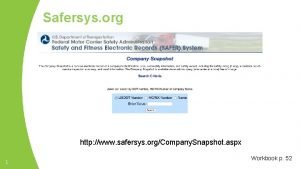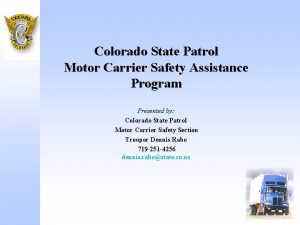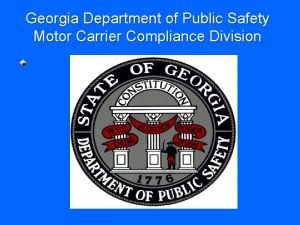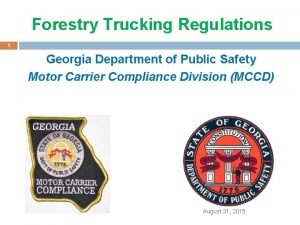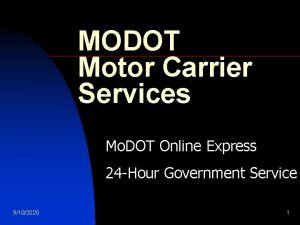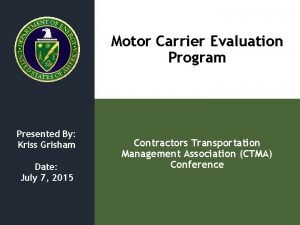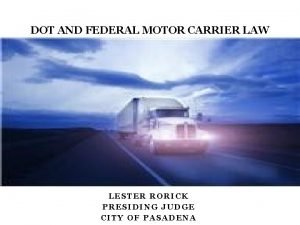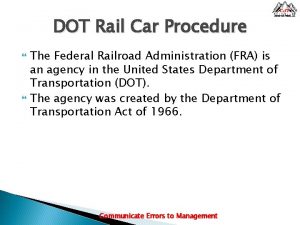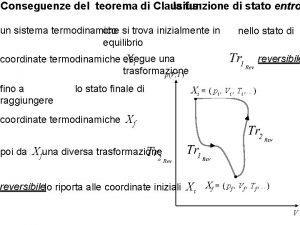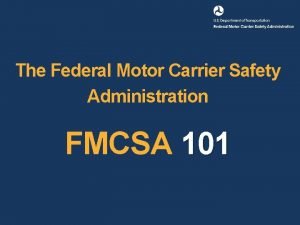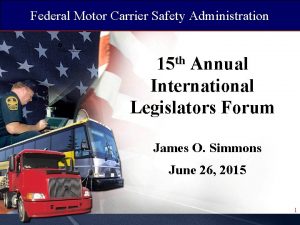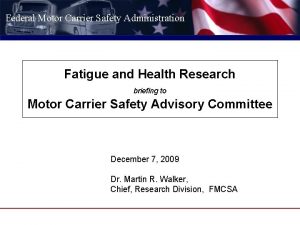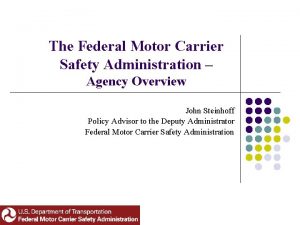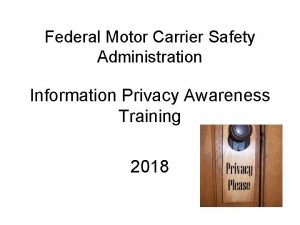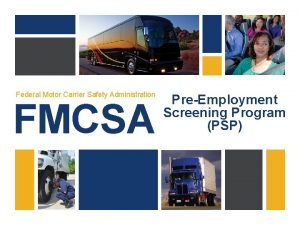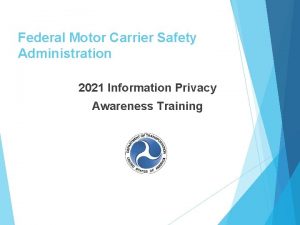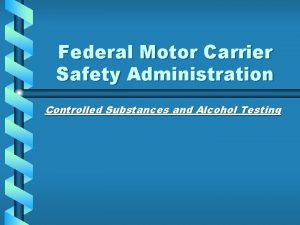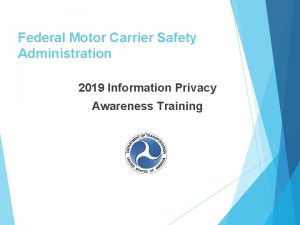Federal Motor Carrier Safety Administration Analysis of HOS














- Slides: 14

Federal Motor Carrier Safety Administration Analysis of HOS Rules briefing to the Motor Carrier Safety Advisory Committee December 7, 2009 Mark Johnson, Economist, Analysis Division FMCSA Barry Galef, Senior Economist, ICF

Overview: Presenters and Topics Mark Johnson, FMCSA: Data Sources for Analysis Ø Crash Data Ø Fatigue Data Ø Industry Data Barry Galef, ICF International: Use of the Data for Regulatory Analysis Ø Cost analysis Ø Benefit analysis Ø Impact analysis FMCSA December 7, 2009 2

Crash Data ► Motor Carrier Management Information System Crash Data (MCMIS) • Fatal, injury, and tow-away crashes, but no associated factor info. ► Fatal Accident Reporting System (FARS) • Only fatal crashes, but has limited associated factor data ► Trucks Involved in Fatal Accidents (TIFA) • Based on FARS, but supplemented with closer scrutiny of police accident reports and follow on questions • Has associated factor and hour of driving information ► Large Truck Crash Causation Study (LTCCS) • Most comprehensive associated factor data • Limited collection period and smaller sample size than other data sources FMCSA December 7, 2009 3

Data on Driving & On-duty Schedules ► FMCSA Field Survey (mostly small carriers) • Average length of tour of duty (on-duty and drive time) • Weekly drive time, and use of 11 th hour and 34 hour restart • Data on local vs. over-the-road drivers ► Schneider Survey (large truck load carrier) • Use of 11 th hour and 34 hour restart • Average daily and weekly duty and driving time ► OOIDA Survey of Owner-Operators • Data on frequency of use of 11 th hour and 34 hour restarts ► Anonymous surveys give indications of compliance • UMTIP survey of truck drivers • IIHS anonymous survey of long-haul truck drivers FMCSA December 7, 2009 4

Industry Profile Data ► Truck driver wage and compensation data: Bureau of Labor Statistics ► Revenue/Profitability data • TTS Blue Book of Trucking Companies for larger firms • Risk Management Association for smaller firms ► Owner-Operator profile – Owner-Operator Independent Driver Association, MCMIS Census ► Total size of the industry – MCMIS Census, OOIDA, TTS, ATA and Economic Census ► Drivers and Power Units – VIUS, TTS, Economic Census, MCMIS and ATA FMCSA December 7, 2009 5

RIA Overview: Answering These Questions ► What is the baseline? ► How do HOS options affect operations? ► How do the operational changes affect … • Industry costs? • Crashes? ► Given these changes, which options are costeffective? ► What impacts are there besides costs and benefits? FMCSA December 7, 2009 6

Establishing an Industry Baseline ► Profile of the Affected Industry • Divide into short vs. long-haul (LH) • Divide into private fleets vs. for-hire • Divide LH into TL (truckload) /LTL (less than truckload) and team/solo ► Operational Patterns • Estimate distribution of freight hauls • Divide into regular/“random” patterns • Estimate current use of HOS provisions FMCSA December 7, 2009 7

Estimating Cost Impacts of HOS Options ►Analysis starts with impacts on schedules ►Regular patterns can be assessed directly ►Complex/irregular operations call for detailed modeling of HOS options • RIA for 2003 rules used commercial software • RIA for 2005 rules used a computer simulation of “drivers” choosing among randomly generated loads under various HOS constraints FMCSA December 7, 2009 8

Valuing Changes in Productivity ►Assuming the same freight needs to be delivered, lower productivity implies more drivers ►Cost of hiring another driver is compared to the cost of using the same drivers slightly more ►Examined the compensation of drivers working different schedules to compare costs ►Found that a 1 percent drop in productivity increases industry costs by about $300 million FMCSA December 7, 2009 9

Overview of Benefits Analysis ►HOS options affect work schedules change in amount and timing of rest change in alertness/fatigue changes in crashes change in damages ►To draw quantitative conclusions, we had to model most of these steps explicitly FMCSA December 7, 2009 10

Effect of Work Schedules on Rest ►Another hour off duty can mean more sleep – but not on a one-to-one basis ► Walter Reed Field Study let us estimate relationship FMCSA December 7, 2009 Hours on Duty Hours of Sleep Δ in Sleep per Hour on Duty 0 8. 3 - 6 7. 6 -0. 1 8 7. 5 -0. 1 10 7. 3 -0. 1 12 6. 9 -0. 2 14 6. 4 -0. 3 16 5. 5 -0. 4 18 4. 3 -0. 6 11

Effect of Changes in Rest on Alertness Driver Health Research ► RIA for 2003 HOS rules used the Walter Reed Sleep Performance Model (SPM) (in Excel) ► For 2005, we used SAFTE/FAST (related to SPM) Regular Schedule FMCSA Irregular Schedule December 7, 2009 12

Separate “Time on Task” Adder for 2005 and After Driver Health Research ► Allowed for an independent effect beyond effect of excessive time awake ► Fit a polynomial, then a logistic, to TIFA data Average Fatigue Involvement in TIFA 30% Cubic Logistic 20% 10% 0% 0 2 4 6 8 10 12 14 16 18 Hours of Driving FMCSA December 7, 2009 13

Assessing the. Research Results Driver Health ► We “monetized” the changes in crashes using a study of crash damages ► Subtracting compliance costs from the dollar value of benefits yielded the net benefit of a proposal ► Some benefits are hard to quantify, though, and are often left out of net benefit calculations ► Other impacts – mode shifts, jobs losses, hardships for small entities – are often important to decision makers, and need to measured FMCSA December 7, 2009 14
 Safersys.org
Safersys.org Motor carrier safety assistance program
Motor carrier safety assistance program Motor carrier safety consulting inc
Motor carrier safety consulting inc Motor carrier compliance division
Motor carrier compliance division Ucr registration ga
Ucr registration ga Modot express
Modot express Modot motor carrier express
Modot motor carrier express Modot motor carrier express
Modot motor carrier express Is federal housing administration relief recovery or reform
Is federal housing administration relief recovery or reform Federal aviation administration purpose
Federal aviation administration purpose Federal railroad administration train car
Federal railroad administration train car Baser egenskaper
Baser egenskaper Who is the manager of the school
Who is the manager of the school Leder titan ström
Leder titan ström Hos entropia
Hos entropia
